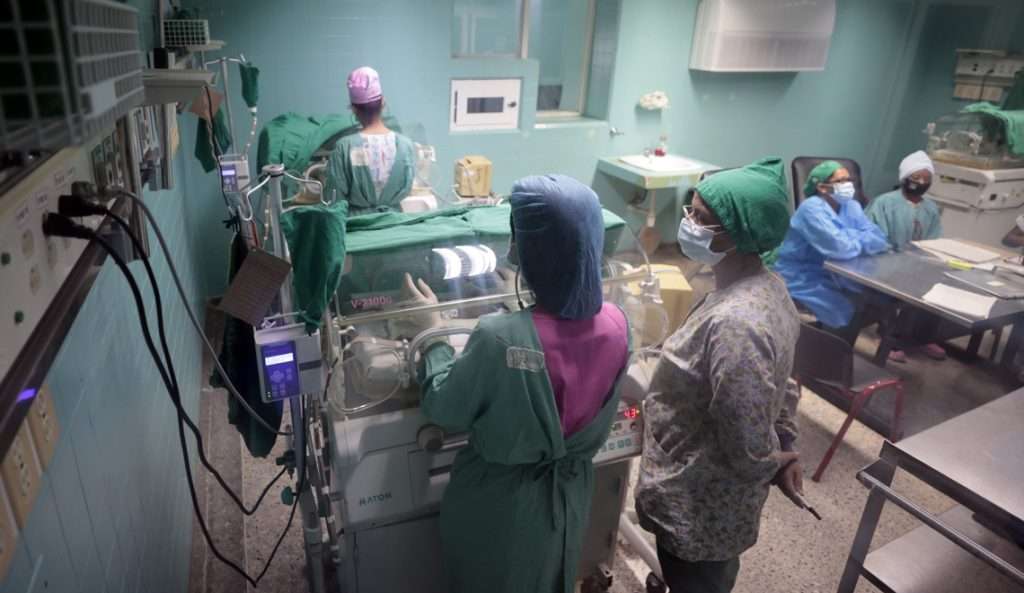In a informative note published days ago on its official site, the Ministry of Public Health of Cuba gave an account of the death of “eight newborns with low birth weight and prematurity” in january. It happened at the 10 de Octubre Gynecologist Hospital in Havana. Four of the babies “died after day 11 with presumptive signs of sepsis.”
The note ensures that “the necessary measures have been adopted” and that the hospital “has the necessary resources.” Finally, it clarifies that a commission from the Ministry is investigating the causes of the event and that “the pertinent measures will be applied.”
What happened, due to its unusualness, has generated comments and a negative state of opinion. On the other hand, it directly affects one of the most important indicators for MINSAP: infant mortality.
For more than a century, the indicator is considered one of the most sensitive and accepted measures of health and social well-being in the world. In fact, its reduction is part of the UN Sustainable Development Goals for 2030.
Infant mortality in Cuba
According to 50th edition of the National Health Yearbookthe Infant Mortality Rate (IMR) in Cuba went from 38.7 per thousand live births in 1970 to 7.9 in 1996. Since then it has continued to decrease and between 2008 and 2018 it remained below 5. rates of 4.0 deaths per thousand live births in 2017 and 2018.
For the Ministry of Public Health and the Cuban State, have the lowest IMT of Latin America and the Caribbean, and one of the smallest in the world, has been a source of legitimate pride.
However, in 2021 Y 2022 the downward trend has been reversed. Figures above 7 have been registered, which brought the country back to the results of the 90s. The trend also occurs in a context of reduced birth rates.
On the other hand, the behavior of the IMT was not homogeneous in these years. In fact, in 2022 we can group the territories into three large groups: those that presented less than 5 deaths per thousand live births, from 5 to 9 and more than 9. The provinces that are in the last group are Camagüey (with 9, one); Havana (with 9.5); Guantanamo with (9.7); Santiago de Cuba with (9.9) and Mayabeque with (12.2).
It is striking that Havana and Santiago de Cuba, the two provinces that contribute the highest number of births in the country, are in the group.
Conditions of the perinatal period, the main cause of the increase
The main cause of death in children under twelve months of age in the last five years in Cuba has been conditions during the period that includes the first 7 days of the baby’s life, known as “perinatal”.
I know include Dozens of pathologies of the mother and the newborn that can affect them before, during and after birth. The perinatal death rate experienced impressive growth from 2018 to 2021: from 231 to 469 deaths: more than double.
This behavior explains, to a large extent, the retracement of the indicator. Note that of the 754 children who died in 2021, 469 did so in the perinatal period. Congenital malformations were five times the cause of death.
In July 2022 the Minister of Public Health he pointed Prematurity and low birth weight, together with congenital malformations and sepsis, are the main determining factors for perinatal death.
In line with the above, a study carried out in Cuba found that among the risk factor’s The first of perinatal deaths is preterm birth (every child born alive before 37 weeks of gestation). It is not a problem only of Cuba. According to the World Health Organization (WHO), every year 15 million premature babies are born in the world; that is, 1 out of 10.
Of these, approximately one million die from complications of childbirth and a significant number are left with some type of disability. Prematurity is the leading cause of death in children under 5 years of age in the world. Hence the importance of avoiding it.
Another risk factor for perinatal death is low birth weight. The OMS defines it as “a birth weight of less than 2,500 g”. Being underweight is a major public health problem, because children born with the condition present eight to 10 times higher risk of disease and death.
In addition, they can suffer sequelae after birth due to asphyxia during childbirth, pulmonary bleeding, hypothermia (low temperature) and poor physical and mental development.
Risk factors for low birth weight they divide themselves into three large groups: pre-conception (before pregnancy, including the mother’s educational level, weight, height, previous illnesses, etc.), those during pregnancy (series of illnesses and events that can occur during the period) and , finally, environmental and behavioral risk factors (from excessive work and altitude, to habits such as excessive consumption of coffee, drugs, alcohol or tobacco).
Finally, it is understood by septicemia the exaggerated response of the body to an infection. It is considered a medical emergency and has a high mortality rate in all age groups; but it is greater in the extreme ages of life. Between the causes there are both bacteria and viruses and, in the case of newborns, it is associated with a series of factors such as the aforementioned preterm delivery, maternal infections, etc.

Decrease the Infant Mortality Rate (IMR)
To reduce the Infant Mortality Rate (IMR) in Cuba, the number of deaths due to perinatal conditions should be reduced. In turn, this will happen by reducing the numbers of children born prematurely and with low weight.
It is said easy but it is tremendously complex. The roots of the problem are diverse and many of them are difficult to change. For example, the height and sociocultural level of mothers and families.
On the other hand, the Ministry of Public Health has not escaped the ravages of the economic and social crisis that the island is going through. Among the causes indicated last year to obtain results in the TMI were: “incomplete templates of cadres and officials” in nine of the fifteen provinces of the country.
It would be necessary to add the lack of resources, which —although to a lesser extent, since PAMI is a prioritized program— also affects. The low investment in the sector and the emigration of qualified personnel, especially in primary care, the same.
Although official statistics on the subject are not public, it is clear that among the more than 200,000 Cubans who arrived in the United States in 2022, a part have been health personnel.
On the other hand, there is demotivation due to the working conditions and salaries of health workers. Despite being above average in the Cuban salary scalehave suffered a significant loss of their purchasing power due to inflation.
All of the above is taxed to the results.
Returning to what was achieved in the 2008-2018 decade should be the goal; but it won’t be easy. Adequate maternal and child care begins long before pregnancy, with the identification of the population at risk, the carrying out of health promotion and prevention activities, the early recruitment of the pregnant woman, a timely follow-up that includes the work of a multidisciplinary team. and, in some cases, admission to maternity homes or hospitals.
Continuous training of staff must be maintained, from the base to the tertiary level, in a crisis context. In addition, better care is needed at the time of delivery and the perinatal period; which requires significant organizational work throughout the country, but especially in the provinces with the worst results.
In short, what happened in a hospital in Havana in particular, and the results of infant mortality in general, reflect the crisis that the country is going through. Reaching the levels we had five years ago took decades; reversing the current ones will not be a matter of a day.















